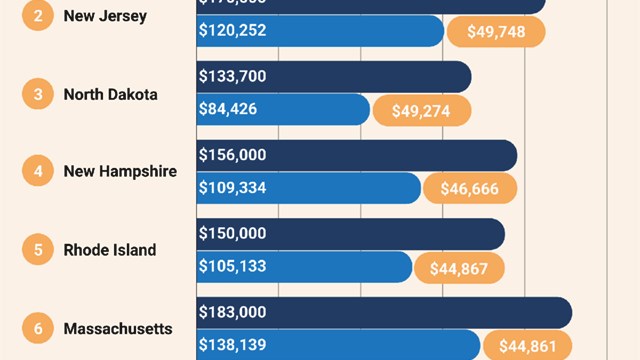Once again, the New York City market is on an upswing as far as condos and co-ops are concerned. The days of the 2007-08 recession seem to be behind us at last, and professionals don’t foresee that trend changing much in the year ahead. “I don’t see any recession in the real estate market,” says Richard Schulhoff, executive director of the Brooklyn Board of Realtors. “The market is as hot as ever—I’m surprised it’s sustained this level for so long.”
A Look at the Numbers
Michael Slattery, senior vice president for research of the Real Estate Board of New York (REBNY) gives some numbers. “Our latest New York City Residential Sales Report showed that $13.6 billion in citywide total consideration (monetary value for completed home sales transactions) was completed in the third quarter of 2016 for the sale of cooperatives, condominiums, and one- to three-family dwellings. This 15 percent rise from the third quarters of 2015 is the greatest total value of home sales transacted in the five boroughs within one quarter since we began tracking home sales data in 2006.”
REBNY’s third-quarter report breaks this down by borough and by neighborhood. According to the report, “The average sales price of a condo in Manhattan during the quarter was $2,952,000 - a 44 percent increase over the year—while the Brooklyn average sales price increased 14 percent to $1,043,000. The average sales price for a condominium unit in Queens was $568,000 this quarter, a 13 percent increase from last year’s third quarter average.”
As far as co-ops are concerned, “When compared to the third quarter of 2015, the average sales price of a co-op in Manhattan increased two percent to $1,214,000. Brooklyn saw a seven percent increase in the average co-op sales price, rising to $535,000 from the third quarter of 2015, while the average sales price of a co-op in Queens rose three percent to $266,000.” However, the average sales price of a Bronx co-op decreased 4 percent from the year-before figure.
The same reports highlights specific neighborhoods like Midtown East, where the average price of a condo unit increased three times over the previous year; and Flushing, Queens, which saw an increase of 28 percent in the number of condo sales over the same period in 2015. Demand for co-ops on the Upper East Side fell 15 percent, although prices there increased slightly, according to the report. Conversely, the average price of a Williamsburg condo fell 5 percent, but the number of sales in the neighborhood increased 2 percent.
A `New Normal’
Even though the market is on an upswing, Jeremy Swillinger, a top sales agent from the Level Group, believes that a “new normal” is being accepted—the frenzied atmosphere of the boom years appears to have passed. “No more listing the property and it selling in a massive bidding war within the first week of being on the market,” he says. “Properties that are priced with realistic expectations are selling, and properties that are priced too aggressively tend to sit on the market until a downward price correction has been acknowledged.” That being said however, Swillinger adds that most buyers anticipate a rise in interest rates during the next year or two, making a purchase in the near future more attractive than waiting too long.
Talking about the ultra-high-end luxury market in particular, Gary Malin, president of Citi Habitats, says that this sector is in the process of finding equilibrium between selling and buyers. In general, he says, “While there is still strong demand, ultimately price dictates everything. The good news for apartment seekers is that the market is more in their favor than it was previously.”
Richard Grossman, president of Halstead Property, sees a wide variety of price point selling. The market for properties priced below $3 million, he says, is still active. Homes priced between $3 million and $10 million, depending on the area, “have seen a slight adjustment in value, but we are still seeing activity.” As for properties priced above $10 million, they are also still selling, but his firm is seeing “an influx in inventory coming on the market at that price point.”
However, Slattery of REBNY strikes a cautionary note, although one that affects the rental market, not the condo and co-op market. “The continued suspension of 421-a threatens the production of rental housing throughout New York City, both market-rate and affordable.”
New Developments
What’s new and exciting on the horizon in terms of new and upcoming residential development projects?
The pros interviewed by The Cooperator mentioned several new buildings:
Solow Building Corporation’s 685 First Ave., designed by celebrated architect Richard Meier and reaching a height of 42 stories. The tower, says Malin, is scheduled for completion in 2018.
• The Renzo Piano-designed residential building at 565 Broome St.
• Rafael Viñoly 125 Greenwich St. condo.
• The 54-story Robert A.M. Stern-designed condo at 520 Park Avenue.
• Cherit Group and Clipper Equity’s Gramercy Square, featuring a 75-foot sky-lighted pool with steam and sauna rooms.
JDS’s luxury rental American Copper Buildings on First Avenue in Kips Bay, which have a unique sky bridge between two identical towers that will hold a 75-foot lap pool, hot tub and spa.
Trends in Amenities
Additional aspects to factor into the co-op condo real estate market are floor plans and amenities. While they remain as important as ever, which amenities are touted in what building depends on price point and location.
Malin of Citi Habitats, for example, says many high-end buyers are requesting units with “art walls,” meaning large expanses of blank wall on which they can showcase their art collections. In addition, he says, there has been a noticeable shift from “open plan” design—for example, the closed kitchen is making a comeback in some circles.
But as usual, there is a sense of one-upmanship among developers in terms of amenities. “Many of today’s buildings,’ Malin adds, “offer residents a complete lifestyle. Lavish pools, fitness facilities and spas, plus screening rooms, children’s playrooms, art studios and even golf simulators have become par for the course.”
According to Swillinger, some developers are even willing to absorb the cost of altering a floor plan for a particular buyer. “This could include a developer moving a kitchen around during the construction phase to accommodate a buyer’s quest for a wet bar area,” he says, “Or perhaps a buyer wants a different type of hardwood floor—a developer of a luxury condo that has been struggling with sales might accept the reinstallation of a different type of floor in order to make a purchaser happy. Developers might also accept installing wireless audio and visual amenities in the apartment at the request of a buyers.” This wasn’t always the case as recently as just 12 or 24 months ago.
Grossman of Halstead Property, on the other hand, sees a return to the basics. “New developers have moved away from the gimmicky amenities like dog-grooming rooms and are focusing on what buyers need, like storage rooms, playrooms and quality finishes.”
Schulhoff also talks about the basics. In Brooklyn high-rises, he says, the focus is on security, such as having a 24-hour doorman. In smaller buildings, such as those found in the more outlying areas of the borough, parking is important—“We get a lot of requests for parking.” And of course being near public transportation is also a plus.
Retaining Market Value
Just as there are hot amenities, there are, and always have been, hot neighborhoods in the city. We asked those we interviewed which areas are expected to hold or increase their property values, and which are more sluggish.
In Manhattan, says Malin, areas like the West Village, SoHo and TriBeCa continue to have some of the highest property values in the city. “Homes adjacent to the massive Hudson Yards project on the West Side will likely see a jump in value, as a development of that scale will reinvent and revitalize the surrounding community,” he adds.
Swillinger highlights the Fur District, in the upper 20s and lower 30s on the West Side, just south of Penn Station. The area was once home to the fur industry, but by the late 1980s, many furriers in the neighborhood had closed up shop. Some of their studios and showrooms were transformed into loft-like condos that allow a live-work scenario. The uniqueness of the architectural details and the closeness to Penn Station, High Line Park, Hudson Yards and more point to a positive forecast for the neighborhood, he says.
Interestingly, experts see both the Upper East Side and the Lower East Side appreciating in value and generating more interest once the Second Avenue Subway comes to those neighborhoods. The Second Avenue line debuted the Upper East Side on January 1, but it could be years before it reaches to the Lower East Side.
Outside of Manhattan, experts see continued interest in Long Island City, Bushwick, Greenpoint and similar neighborhoods. Grossman sees “tremendous price appreciation” in Brooklyn, especially in areas such as Bedford-Stuyvesant and Prospect Heights. Often, Brooklyn areas become trendy because they are next to other fashionable areas that have become saturated—for example, Bushwick and Greenpoint both abut Williamsburg, and have seen their numbers rise as buyers find themselves priced out (or just tired of) the Williamsburg scene. Still, activity may be stalled somewhat in Williamsburg and its adjacent neighborhoods due to the looming 18-month shutdown of the L train, which is North Brooklyn’s main lifeline to Manhattan.
In Queens, Swillinger is enthusiastic about Long Island City, “Due to its ease of access to the city, amazing restaurants, art galleries, blossoming waterfront and family-friendly atmosphere. It will continue to be a prospering neighborhood and values will continues to increase.” He expects double-digit returns during the next few years.
In the Bronx, activity continues to increase steadily. Riverdale continues to be as attractive as always; parts of the South Bronx, such as Mott Haven, are becoming trendy, and may see an increase in property values; and Pelham Parkway is beginning to generate some interest as well.
Getting the Most for Your Money
As far as getting the most for your money and retaining future high selling value are concerned, there are many places where buyers can get good deals, including Harlem, Washington Heights and Riverdale. “Each of these neighborhoods,” says Grossman, “have great transportation, beautiful housing stock and great local services. I believe properties here will retain – if not experience an increase in – their value.”
Looking toward Brooklyn, Schulhoff feels that the next big area in the borough will be East New York – a neighborhood that until recently, most middle-class buyers eschewed because of its distance from Manhattan and its high crime rate. The interest in East New York could be compared to the focus on Red Hook and Williamsburg 10 years ago, and on Carroll Gardens and Boerum Hill before that.
There’s one thing everyone agrees on – no matter what happens, New York will continue to be a magnet for buyers. Younger people are expected to flock to the city as they have since the city rebounded from the bankruptcy era of the 1970s, and many baby boomers will see living in the city as an attractive alternative to retiring to Florida, California or Arizona. From the ease of transportation that the subway system offers to the United Nations to the financial district to the theater, New York City has it all.
And, as Slattery reminds us, “It’s the safest large city in America.”
Ranaan Geberer is a freelance writer and editor, and a regular contributor to The Cooperator.







Leave a Comment